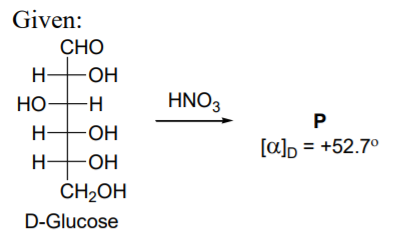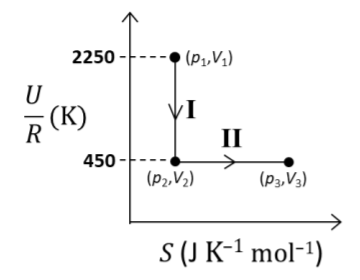QUESTION from JEE ADVANCED PREVIOUS YEAR Chapter 5 JEE ADVANCED 2021 for Class 12
| Class 12 | CHEMISTRY |
| Chapter | JEE ADVANCED 2021 |
| JEE ADVANCED PREVIOUS YEAR | QUESTION |
| Medium | English |
| Academic Year | 2023-2024 |
Question 7
For the reaction , X(s)↔Y(s)+Z(g), the plot of lnpzpθ versus 104T is given below (in solid line), where pz is the pressure (in bar) of the gas at temperature T and pθ= 1bar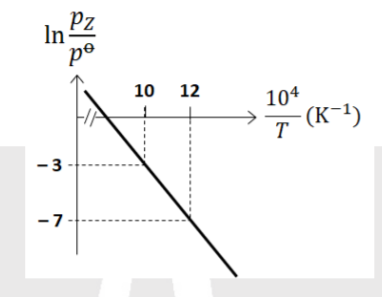
( Given, d(lnK)d(1T)=−ΔHθR, where the equilibrium constant , K=pzpθ and the gas constant, R=8.314JK−1mol−1
The value of standard enthalpy,ΔHθ(in kjmol−1) for the given reaction is ---------View SolutionQuestion 8
For the reaction , X(s)↔Y(s)+Z(g), the plot of lnpzpθ versus 104T is given below (in solid line), where pz is the pressure (in bar) of the gas at temperature T and pθ= 1bar
( Given, d(lnK)d(1T)=−ΔHθR, where the equilibrium constant , K=pzpθ and the gas constant, R=8.314JK−1mol−1
The value of ΔSθ(in jmol−1) for the given reaction at 1000K is ---------View SolutionQuestion 9
The boilingpoint of water in a 0.1 molal silver nitrate solution(solutionA) is x∘C. To this solution A, an equal volume of 0.1 molal aqueous barium chloride solution is added to make a mew solution B. The difference in the boiling points of water in the two solutions A and B is y×10−2∘C
(Assume: Densities of the solutions A and B are the same as that of water and soluble salts dissociate completely.
Use:molal elevation constant (Ebullioscopic constant),Kb=0.5Kkgmol−1 Boiling point of pure water as 100∘C)
The value of x is ---------.View SolutionQuestion 10
The boilingpoint of water in a 0.1 molal silver nitrate solution(solutionA) is x∘C. To this solution A, an equal volume of 0.1 molal aqueous barium chloride solution is added to make a mew solution B. The difference in the boiling points of water in the two solutions A and B is y×10−2∘C
(Assume: Densities of the solutions A and B are the same as that of water and soluble salts dissociate completely.
Use:molal elevation constant (Ebullioscopic constant),Kb=0.5Kkgmol−1 Boiling point of pure water as 100∘C)
The value of |y| is ---------.View SolutionQuestion 23
Some standard electrode potentials at 298K are given below:
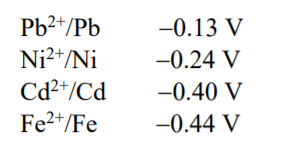
To a solution containing 0.001M of X2+ and 0.1M of Y2+, the metal rods X and Y are inserted (at298K) and connected by a conducting wire. This resulted in dissolution of X. The correct combinations of X and Y, respectively is (are)
(Given: Gas constant, R=8.314JK−1mol−1, Faraday constant,F= 96500Cmol−1)View SolutionQuestion 26
At 298K, the limiting molar conductivity of a weak monobasic acid is 4×102Scm2mol−1. At 298K, for an aqueous solution of the acid the degree of dissociation is α and the molar conductivity is y×102Scm2mol−1. At 298K, upon 20times dilution with water, the molar conductivty of the solution becomes 3y×102Scm2mol−1 The value of α isView SolutionQuestion 27
At 298K, the limiting molar conductivity of a weak monobasic acid is 4×102Scm2mol−1. At 298K, for an aqueous solution of the acid the degree of dissociation is α and the molar conductivity is y×102Scm2mol−1. At 298K, upon 20times dilution with water, the molar conductivty of the solution becomes 3y×102Scm2mol−1 The value of y isView SolutionQuestion 28
Reaction of xg of Sn with HCl quantitatively produced a salt. Entire amound of the salt reacted with yg of nitrobenzene in the presence of required amount of HCl to produce 1.29g of an organic salt(quantitatively).
(Use Molar masses (in gmol^(-1)) of H,C,N,O,Cl and Sn as 1,12,14,16,35 and 119 respectively). The value of x is ----------.View SolutionQuestion 29
Reaction of xg of Sn with HCl quantitatively produced a salt. Entire amound of the salt reacted with yg of nitrobenzene in the presence of required amount of HCl to produce 1.29g of an organic salt(quantitatively).
(Use Molar masses (in gmol−1) of H,C,N,O,Cl and Sn as 1,12,14,16,35 and 119 respectively). The value of is ----------.yView SolutionQuestion 30
A sample (5.6g) containing iron is completely dissolved in cold dilute HCl to prepare a 250ml of solution. Titration of 25.0ml of this solution requires 12.5ml of 0.03M KMnO4 solution to reac the end point. Number of moles of Fe2+ present in 250ml solution is X×10−2(consider complete dissolution of FeCl2). The amont of iron present in the sample is y% by weight
Assume: KMnO4 reacts with Fe2+ in the solution
Use: Molear mass of iron as 56gmol−1 The value of X is------.View SolutionQuestion 31
A sample (5.6g) containing iron is completely dissolved in cold dilute HCl to prepare a 250ml of solution. Titration of 25.0ml of this solution requires 12.5ml of 0.03M KMnO4 solution to reac the end point. Number of moles of Fe2+ present in 250ml solution is X×10−2(consider complete dissolution of FeCl2). The amont of iron present in the sample is y% by weight
Assume: KMnO4 reacts with Fe2+ in the solution
Use: Molear mass of iron as 56gmol−1 The value of is------.yView SolutionQuestion 32
The amount of energy required to break a bond is same as the amount of energy released when the same bond is formed. In gaseous state, the enrgy required for hololytic cleavage of a bond is called Bond Dissociation Energy(BDE) or Bond Strength. BDE is affected by s-character of the bond and the stability of the radicals formed. Shorter bonds typically stronger bonds. BDEs for some bonds are given below:
Correct match of the C-H bonds(shown in bold) in column J with their BDE in column K is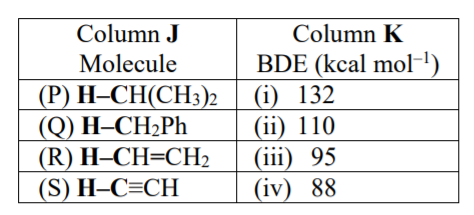 View Solution
View SolutionQuestion 33
The amount of energy required to break a bond is same as the amount of energy released when the same bond is formed. In gaseous state, the enrgy required for hololytic cleavage of a bond is called Bond Dissociation Energy(BDE) or Bond Strength. BDE is affected by s-character of the bond and the stability of the radicals formed. Shorter bonds typically stronger bonds. BDEs for some bonds are given below:
For the following reaction
CH4(g)+Cl2(g)light−−→CH3Cl(g)+HCl(g)
the correct statement isView SolutionQuestion 34
The reaction of K3[Fe(CN)6] eith freshly prepared FeSO4 solution procues a dark blue precipitate caleed Turnbull's blue. Reaction of K4[Fe(CN)6] with the FeSO4 solution in complete absence of air produces a white precipitate X, which turns blue in air. Mixing the FeSO4 solution with NaNO3, followed by a slow addition of concentrated H2SO4 through the side of the test tube produces a brown ring.
Precipitate X isView SolutionQuestion 35
The reaction of K3[Fe(CN)6] eith freshly prepared FeSO4 solution procues a dark blue precipitate caleed Turnbull's blue. Reaction of K4[Fe(CN)6] with the FeSO4 solution in complete absence of air produces a white precipitate X, which turns blue in air. Mixing the FeSO4 solution with NaNO3, followed by a slow addition of concentrated H2SO4 through the side of the test tube produces a brown ring.
Among the following, the brown ring is due to the formation ofView SolutionQuestion 37
Consider a helium(He) atom that absorbs a photon of wavelength 330nm. The change in the velocity (in cms−1) of He atom after the photon absorption is------.
(Assume: Momentum is consrves when photon is absorder.
Use:Plank constant=6.6×10−34Js, Avogadro number= 6×1023mol−1, molar mass of He= 4gmol−1View Solution

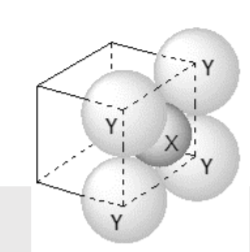
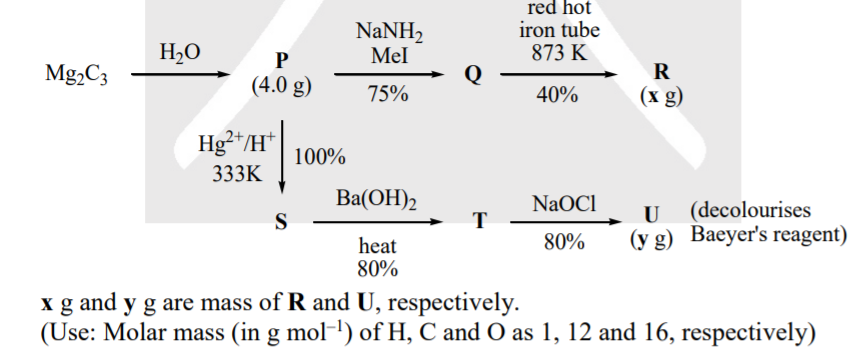 The value of "x" is
The value of "x" is